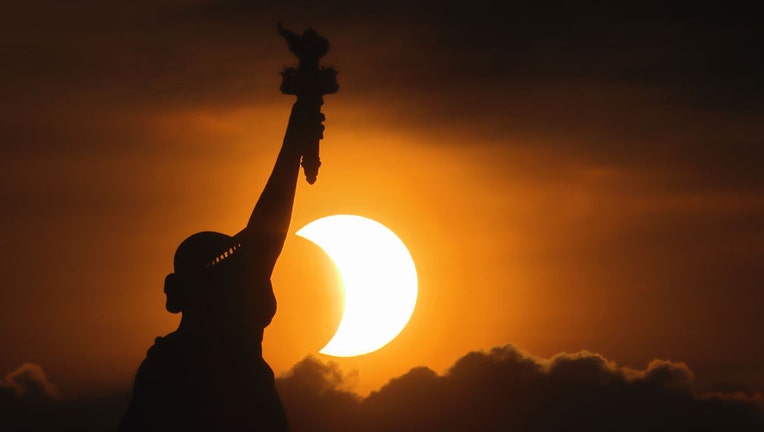What is the annular ‘ring of fire’? This next eclipse happens in less than a month

FILE-The sun rises next to the Statue of Liberty during an annular eclipse on June 10, 2021 in New York City. (Photo by Gary Hershorn/Getty Images)
Americans across the nation enjoyed April’s solar eclipse, and while this rare spectacle will not occur again for years, fans can see another similar event when the annular eclipse takes place in early October.
What is the annular ‘ring of fire’ eclipse?
The annular eclipse, also known as the "ring of fire," occurs when the moon appears slightly smaller than the sun, covering only part of the sun's disk and creating the appearance of a ring of light outlining the moon's silhouette, per the Planetary Society. This thin line surrounding the moon is called an "annulus."
RELATED: Solar eclipse 2024: Photos, videos from across the US
Annular solar eclipses occur when the moon is farther from Earth. Meanwhile, the moon's shadow does not completely block out the sun's light, instead a ring of sunlight is visible around the moon, according to Space.com.
When is the annular ‘ring of fire’ solar eclipse?
The "ring of fire," will occur on Wednesday, Oct. 2, 2024 and will happen in phases, according to Time and Date data.
Where is the annular eclipse visible?
Hawaii is the only state in the U.S. expected to have a partial view of the annular eclipse.
A partial eclipse will be viewable from Hawaii starting around 6:10 a.m. Hawaii Standard Time (HST) and ending at 7:57 a.m. HST.
RELATED: When is the next solar eclipse?
Several cities in Hawaii will be able to view some of the partial eclipse in the early morning hours of Oct. 2. (all times in HST, via Time and Date):
- Hilo - Viewable between 5:44 a.m. and 7:56 a.m.
- Honolulu - Viewable between 5:45 a.m. and 7:52 a.m.
- Kailua-Kona - Viewable between 5:44 a.m. and 7:56 a.m.
- Lihue - Viewable between 5:46 a.m. and 7:51 a.m.
- Napili-Honokowai - Viewable between 5:45 and 7:53 a.m.
- Wailuku - Viewable between 5:45 a.m. and 7:54 a.m.
- Waipahu - Viewable between 5:45 a.m. and 7:52 a.m.
The solar eclipse can be viewed from parts of South America, the Pacific Ocean, the Atlantic Ocean, and Antarctica.
Other areas and countries that may see a partial eclipse include, American Samoa, Antarctica, Bolivia, Brazil, Cook Islands, Ecuador, Falkland Islands, Fiji, French Polynesia, Kiribati, Mexico, and New Zealand.
What is unique about the annular solar eclipse?
The annular solar eclipse is significant for a few reasons because it follows the solar eclipse from April 8, it’s also a longer eclipse, with the ring of fire lasting a little over seven minutes, which is longer than the last annular solar eclipse on Oct. 14, 2023, according to Space.com.
How can I safely watch the annular solar eclipse?
During a partial or annular solar eclipse, it is never safe to look directly at the eclipse without proper eye protection. According to Space.com, when watching a partial or annular solar eclipse directly with your eyes, you must look through safe solar viewing glasses ("eclipse glasses") or a safe handheld solar viewer at all times.

